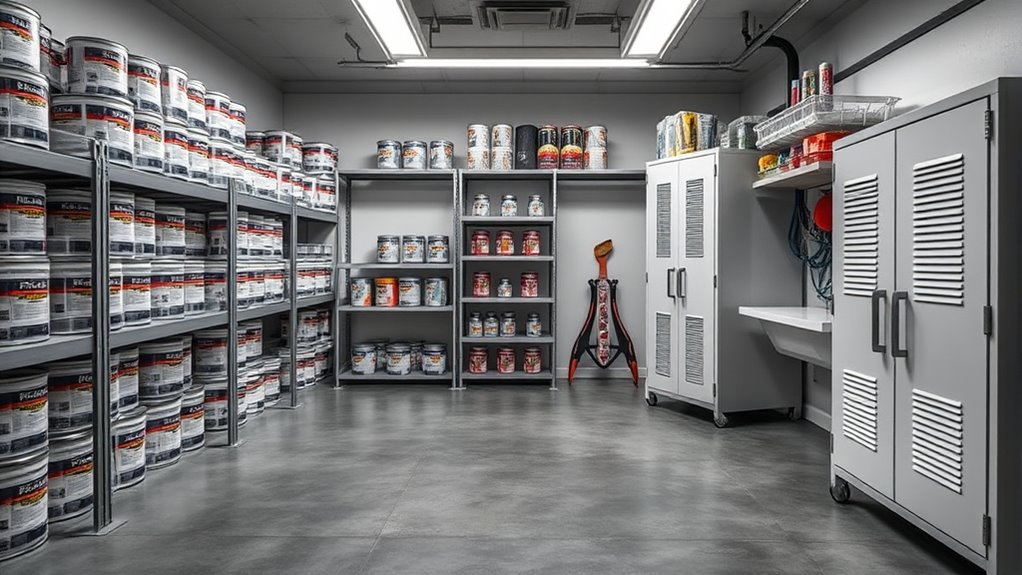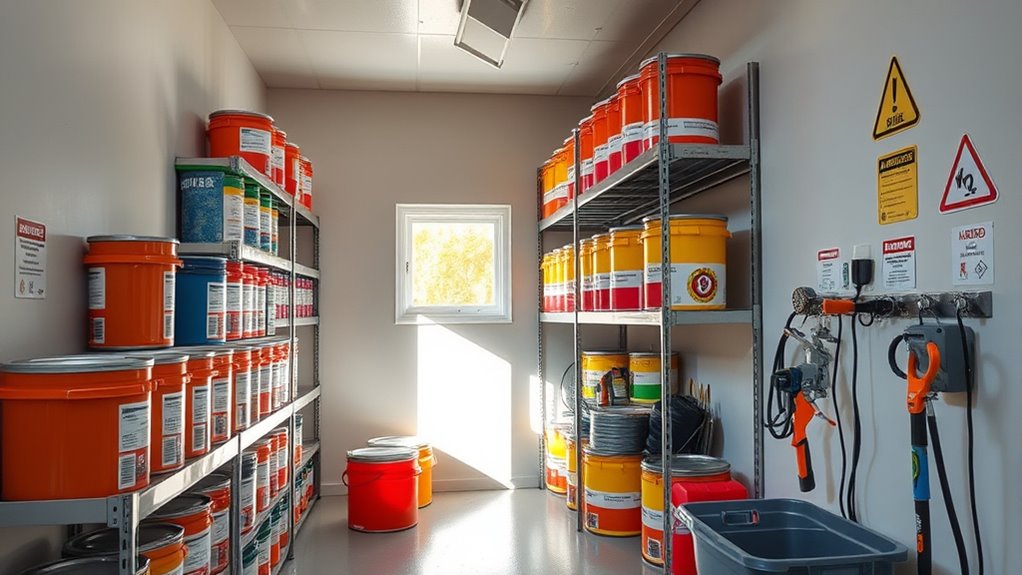To store paint and equipment safely, guarantee your space is well-ventilated to prevent fumes from accumulating. Keep paints in a cool, dry environment away from heat sources, and always seal containers tightly to avoid spills and evaporation. Label containers clearly with contents and safety warnings. Store brushes and rollers in sealed bags, and regularly check for damage. Proper storage extends the life of your supplies and keeps your environment safe—continue for more detailed tips and guidance.
Key Takeaways
- Store paint in a cool, dry, well-ventilated area away from heat sources and direct sunlight.
- Clearly label all containers with contents, purchase date, and safety warnings.
- Keep lids tightly sealed and store brushes, rollers, and sprayers in sealed containers or bags.
- Avoid storing paint in enclosed spaces like basements or small closets to prevent fume buildup.
- Follow safety precautions by ensuring proper ventilation and handling to minimize fire and health hazards.

Properly storing paint and equipment is essential for safety and maintaining their quality. When you’re organizing your supplies, paying attention to ventilation considerations is crucial. Paint fumes can be hazardous, especially in enclosed spaces, so you should ensure the storage area is well-ventilated. Good airflow helps disperse volatile organic compounds (VOCs) and reduces the risk of fumes building up to dangerous levels. If possible, store paints in a room with windows or exhaust fans, or in a space with a dedicated ventilation system. Avoid storing paint in basements or small closets that lack proper airflow. This not only improves safety but also helps prevent the buildup of fumes that could cause health issues or even fire hazards.
Container labeling plays a vital role in safe storage practices. Always double-check that paint containers are clearly labeled with their contents, date of purchase, and any special handling instructions. Proper labeling helps you quickly identify the type of paint—whether oil-based, water-based, or specialty coatings—and ensures you handle each appropriately. If a container’s label becomes damaged or unreadable, transfer the paint to a new, clearly labeled container before storing it away. This prevents accidental misuse or mixing of incompatible paints, which could lead to dangerous reactions or compromised finishes. Additionally, labels should include any safety warnings, such as flammability or toxicity notices, so you’re aware of the precautions necessary when handling or storing these materials.
Furthermore, considering the contrast ratio of your storage space can help you determine if the environment is suitable for maintaining paint quality, as exposure to light and temperature fluctuations can affect the paint’s consistency and performance. You should also keep paints in a designated storage area that is cool, dry, and out of direct sunlight. Temperature fluctuations can cause the paint to thicken, separate, or spoil, reducing its effectiveness. Avoid storing paints near heat sources like radiators, furnaces, or hot water pipes, which can increase the risk of fire. Proper container sealing is equally important; always make sure lids are tightly secured after use to prevent spills, evaporation, or contamination. When storing equipment like brushes, rollers, and sprayers, keep them in sealed containers or bags to prevent dust and dirt from settling on them, which could interfere with future projects.
Frequently Asked Questions
How Long Can Paint Be Stored Before It Expires?
You can typically store paint for about 2 to 5 years before it expires, depending on the type and storage conditions. To maximize its shelf life, follow storage container tips like sealing the lid tightly and keeping the paint in a cool, dry place. Proper storage prevents drying out or separation, ensuring your paint stays usable longer. Always check for signs of spoilage before use, even if the shelf life hasn’t fully elapsed.
Can I Store Paint Outdoors Safely?
Storing paint outdoors is like leaving a delicate flower in the rain—you risk damage and deterioration. You can do it if you choose a secure, shaded storage environment, keeping the paint container upright and tightly sealed. Guarantee it’s protected from extreme temperatures, moisture, and direct sunlight. While outdoor storage is possible, an indoor or shed space offers a safer, more controlled environment, extending your paint’s life and maintaining its quality.
What Are the Signs of Expired or Spoiled Paint?
You’ll notice expired or spoiled paint by a strange paint odor that’s harsher or sourer than usual. The color might also change, turning dull, uneven, or patchy. If the paint has lumps, a strange consistency, or separates easily, it’s likely spoiled. Don’t ignore these signs; using bad paint can ruin your project and cause uneven coverage. Always check for foul smell and color changes before applying or reusing paint.
Is It Safe to Store Paint Near Food Items?
No, it’s not safe to store paint near food items because of the food safety and contamination risk. Paint contains chemicals that can leak or spill, contaminating your food or surfaces. Always keep paint away from food storage areas, utensils, and prepping zones. Proper storage prevents accidental exposure or ingestion of hazardous substances, ensuring your home remains safe and clean. Always prioritize safety over convenience when handling and storing paint.
How Should I Dispose of Leftover or Unused Paint?
You should dispose of leftover or unused paint responsibly by exploring paint recycling options and following proper disposal methods. Check if your local waste facility accepts latex or oil-based paints, or look for community hazardous waste collection events. Never pour paint down the drain or onto the ground. Instead, let latex paint dry out or mix it with absorbing materials, then dispose of it according to local regulations, ensuring environmental safety.
Conclusion
Think of storing paint and equipment like tending a delicate garden. With careful attention and proper storage, you safeguard your tools from the storm of spills and the weeds of decay. When you treat your supplies as precious seeds, they’ll flourish when needed, ready for your next masterpiece. By maintaining a safe and organized space, you guarantee your creative garden remains vibrant and ready to bloom at any moment.










